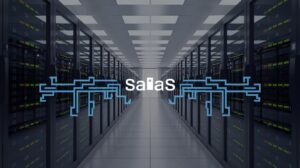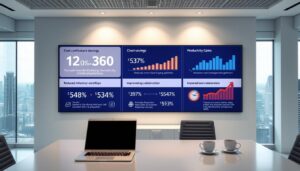SaaS and cloud computing have become the backbone of modern businesses, revolutionizing how companies operate and scale in today’s digital landscape. But what exactly sets them apart, and why are they crucial for your business growth? Whether you’re a tech enthusiast, a business owner, or simply curious about these transformative technologies, this blog will break down the key differences, benefits, and real-world applications of SaaS and cloud computing. By the end, you’ll gain valuable insights to help you make informed decisions about leveraging these technologies for maximum efficiency and growth. Ready to explore the future of business technology? Let’s dive in!
Table of Contents
The Basics of SaaS and Cloud Computing
Software as a Service (SaaS) is a cloud-based model where software applications are delivered over the internet, eliminating the need for local installations. Users can access these applications via a web browser, making them highly convenient and scalable. Cloud computing, on the other hand, refers to the delivery of computing services—including servers, storage, databases, networking, and software—over the internet (“the cloud”). It provides flexible resources, faster innovation, and economies of scale.
Key Differences Between SaaS and Cloud Computing
Here’s a simple comparison table that you can use to create an infographic for visually differentiating SaaS from cloud computing:
| Aspect | SaaS (Software as a Service) | Cloud Computing |
|---|---|---|
| Definition | Software applications delivered over the internet. | Delivery of computing services over the internet. |
| Usage | Ready-to-use applications for end-users. | Infrastructure, platforms, and software services. |
| Deployment | Hosted on vendor’s servers, accessed via browser. | Can be public, private, or hybrid environments. |
| Management | Managed entirely by the service provider. | Requires user management for resources and tools. |
| Customization | Limited customization options. | Highly customizable to fit business needs. |
| Cost Structure | Subscription-based pricing model. | Pay-as-you-go or reserved pricing models. |
| Examples | Google Workspace, Salesforce, Dropbox. | AWS, Microsoft Azure, Google Cloud Platform. |
| Best For | Businesses needing quick, scalable software solutions. | Companies requiring flexible, scalable infrastructure. |
While SaaS is a subset of cloud computing, they differ significantly. SaaS focuses on providing software applications via the cloud, whereas cloud computing encompasses a broader range of services, including infrastructure and platforms. SaaS solutions are ready-to-use applications, while cloud computing offers customizable infrastructure. Use a comparison table to clearly illustrate differences in deployment, access, cost structures, and flexibility.
Benefits of SaaS and Cloud Computing for Businesses

Both SaaS and cloud computing offer distinct advantages. SaaS enhances productivity with easy access to applications from anywhere, reduces IT maintenance costs, and allows automatic updates. Cloud computing improves scalability, provides cost-effective storage solutions, enhances collaboration, and offers robust security measures. Supporting these points with relevant statistics or case studies can add credibility.
Real-World Applications of SaaS and Cloud Computing
Examples of SaaS include Google Workspace, Salesforce, and Dropbox, which streamline business operations and improve efficiency. Cloud computing platforms like Amazon Web Services (AWS), Microsoft Azure, and Google Cloud Platform provide businesses with scalable infrastructure and data management capabilities. Highlight how companies across industries leverage these tools for innovation and growth.
Big Companies Using SaaS and Cloud Computing
Many global companies rely on SaaS and cloud computing to optimize operations and drive growth. Examples include:
- Netflix: Utilizes AWS for its scalable cloud infrastructure to support streaming services.
- Spotify: Leverages Google Cloud for data analytics and personalized recommendations.
- Airbnb: Depends on Amazon Web Services for cloud hosting and data processing.
- Slack: A SaaS platform used widely for team collaboration and communication.
- Zoom: A SaaS-based video conferencing tool that became essential during remote work transitions.
- Adobe: Offers its Creative Cloud suite as a SaaS product for designers and creatives.
- Dropbox: Provides cloud storage solutions accessible from any device.
- Salesforce: A leader in CRM solutions delivered through SaaS.
Challenges and Considerations
Despite their benefits, SaaS and cloud computing come with challenges. Common issues include data security risks, compliance with regulations, potential downtime, and vendor lock-in. Addressing these concerns requires robust security protocols, regular data backups, and careful vendor selection. Offering practical solutions can help businesses mitigate these risks effectively.
How to Choose Between SaaS and Cloud Computing
Choosing the right model depends on business needs. SaaS is ideal for companies seeking ready-to-use software with minimal IT involvement, while cloud computing suits businesses needing customizable infrastructure and extensive data control. Factors to consider include budget, technical expertise, scalability requirements, and security priorities. Providing decision-making frameworks or checklists can guide businesses through this process.
Future Trends in SaaS and Cloud Computing

The future of SaaS and cloud computing is shaped by advancements in artificial intelligence (AI), machine learning, edge computing, and hybrid cloud environments. Businesses can expect more personalized software experiences, increased automation, and enhanced data analytics capabilities. Discussing these trends helps readers understand how to prepare for technological shifts and stay competitive.
Conclusion
In conclusion, understanding SaaS and cloud computing is essential for businesses looking to thrive in the digital age. By exploring their key differences, benefits, and real-world applications, you’re better equipped to make informed decisions that align with your business goals. Whether you’re leveraging the flexibility of SaaS or the robust infrastructure of cloud computing, the future holds immense possibilities.
Now, it’s your turn! Reflect on how these technologies can transform your operations, and don’t hesitate to explore more about AWS Cloud Computing Overview for deeper insights. If you found this article helpful, share it with your network, leave a comment with your thoughts, or subscribe for more tech-driven insights. Remember, embracing the right technology today sets the foundation for tomorrow’s success. [TechGeniuxio.com]





